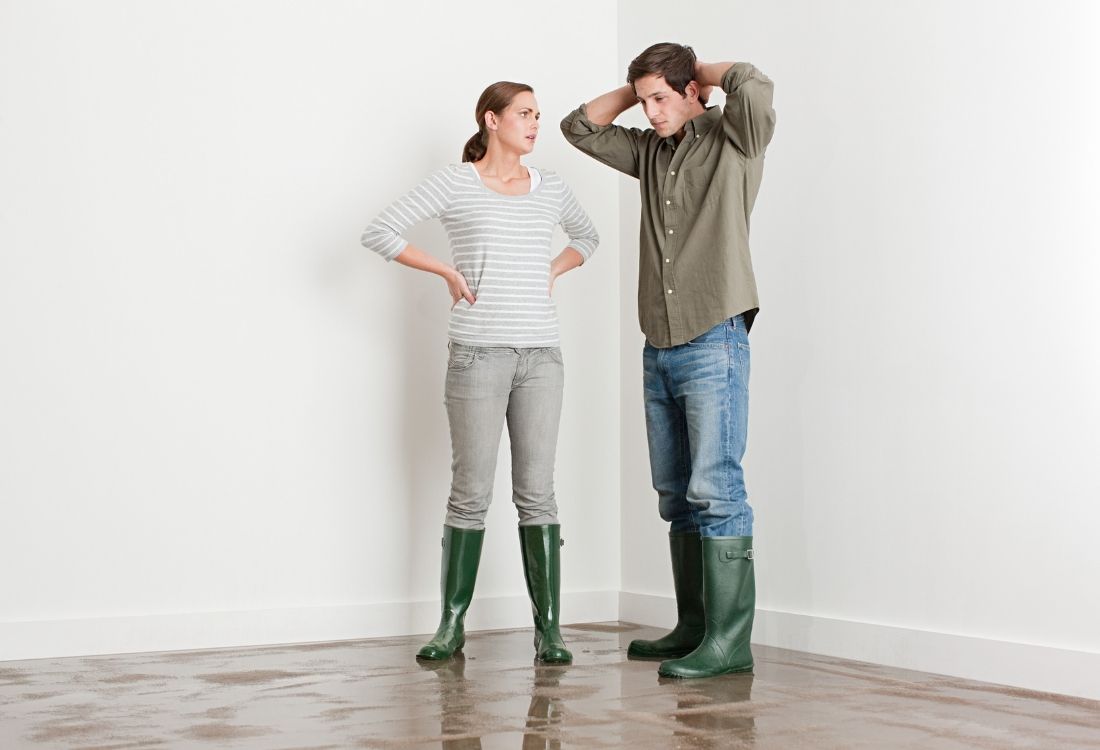

30 Apr Ultimate Guide to Fixing Water Damaged Flooring
Disclaimer: We highly recommend hiring licensed professionals when repairing or replacing water damaged flooring unless you have sufficient DIY knowledge and experience.
Rainy seasons, floor flooding and leaky pipes are often considered the bane of any wood type flooring, after all they bring a plethora of problems to the table. Sometimes the presence of excess moisture alone is enough to cause various flooring problems if left untreated.
This guide is split into four sections to help you find the best solution:
- Identifying water damage
- Repair vs Replacing the floors
- Cost of fixing the floors
- Preventive measures for the future.
Step 1: Identifying Wood Floor Water Damage
Symptoms of water damage can arise in many ways from warping to moulding. Some types of flooring are more prone to absorbing water than other types. Here are the most common forms in which water damage can arise in wood type floors:
Floorboard Warping
The most common symptom of high humidity or direct water exposure is floorboard warping (Includes buckling, cupping and bubbling). Usually this isn’t a major concern however in more severe cases they become unsightly and should be fixed up. Whilst a little bit of warping will not compromise the subfloor’s structural stability or cause any health concerns, they can signify a larger issue which can lead to much bigger problems if left unchecked.
1. Warping from Subfloor Moisture:
High subfloor moisture is more common during rainy seasons when the rain water cannot drain away into the earth fast enough. This is especially true if your property is positioned on low ground where standing water may accumulate.
As a result, moisture can seep through the subfloor, leading to severe floorboard damage over time. Subfloor moisture requires immediate action, especially if your subfloor is wooden (Plywood, Yellow Tongue, Battens, Timber).
Recommended Fix: The first step is to address the elephant in the room – contact your council and arrange for a builder to inspect and identify permanent solutions. Changing the flooring is merely equivalent to throwing towels on the floor and ignoring the leaking tap.
You would want to remove the warping floorboards to check the subfloor condition. If the subfloor is not damaged from the water and is still in a good condition, you’ll only need to dry out the subfloor as quickly as possible before installing new flooring. You will definitely need advice from a licensed builder to avoid more moisture from coming in. FloorVenue recommends using waterproof flooring.
2. Warping from Leaking Pipes:
Similarly, leaky pipes under the floor can also lead to high moisture induced floorboard warping and is more common in kitchen, laundry or bathroom areas.
Recommended Fix: If you identify a leaky pipe, you will need to hire a plumber for the repairs before changing the flooring. Once again, the wet subfloor will need drying which generally takes up to a week or more if there isn’t standing water. You can use fans and other ventilation tools to increase the speed of drying.
3. Warping from Excess Water When Mopping:
A common error is continual moisture from mopping on laminate, hardwood or other wood floors. Over an extended period of regular mopping with excess water can lead to bubbling and cupping on the surface. This can result in water seeping through into the subfloor, which may require drying and makes it more difficult to fix up.
Recommended Fix: If the damage is small, solid timber is salvageable by sanding down to the undamaged surface with polishing for the fresh look. Laminated is not sandable and bamboo floors are very water absorbent. This will likely require repairs for the damaged areas by replacing them.
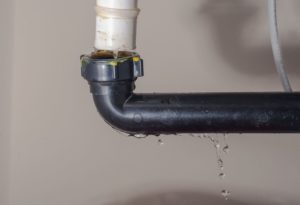

Flooring Discolouration
Wooden floorboards can often darken from ‘spot’ exposure to water. Flooring discolouration is especially common amongst more natural materials like solid timber, engineered timber or bamboo flooring. This is usually caused by mould growth or a chemical known as tannin in the wood reacting with minerals in the rain, which results in blackening of the surface layers.
1. Discolouration From Water:
Flooring discolouration typically emerges near unclosed windows or sliding doors during heavy rains. This results in the same area being exposed to more moisture (and sunlight) which can lead to discolouration over time.
Recommended Fix: The easiest solution for most cases of flooring discolouration is sanding and polishing away the discoloured surface for a freshened look. Sanding and polishing only works if the discolouration has not affected beneath the surface, in which floorboard replacements may be necessary.
2. Discolouration From Pet Accidents:
Dogs and cats which are not potty trained can cause flooring discolouration when they pee on the wood floor.
Recommended Fix: If it is fresh, immediately dry it up and scrub or mop with a vinegar and water mix. Should you be unfortunate enough to discover the accident after it has been soaked for a day or two, you will likely need to repair the floors if cleaning doesn’t fix the colour.
3. Discolouration From Indoor Pot Plants:
One other way in which discolouration can arise is under indoor pot plants which have regular watering. FloorVenue has many times received inquiries about how they can fix the ‘dark pot spot’ when our clients one day decide to change the location of their plants.
Recommended Fix: Solid timber can easily be sanded back and refinished if the discolouration is only surface thin. In worse cases, it will be necessary to replace the planks. Bamboo and laminate floors will also require replacing, which isn’t too difficult and DIY friendly since they are floating floors. This means the laminate and bamboo planks are not directly glued or nailed into the subfloor.
Mould Growth
The emergence of mould colonies can lead to various health and respiratory risks alongside bad odours. This is caused by prolonged exposure to environments with excess moisture, especially in low light areas. Mould does not discriminate between natural and synthetic flooring and can affect wood, plastic or stone types alike!
Recommended Fix: Timber and bamboo floors can be sanded down and bleached to kill the bacteria before polishing for a fresh look. Synthetic options including laminate floors, hybrid flooring or vinyl planks must be replaced with proper chemical cleaning as they cannot be sanded or polished like their natural material counterparts.
Step 2: Repair vs Replace Flooring
The general rule of thumb is that if the water damage is isolated to a specific area, you won’t need to replace the entire floor. Instead, a simple repair job will do the work and save you unnecessary expenses.
Difference between repairing and replacing flooring?
- Repairing the floors involves a sanding and polishing job or replacing a few specific planks of wood floors to fix specific damaged areas. Repairs are recommended for small spot fixes and isolated damages.
- Replacing flooring means ripping up everything and installing new flooring throughout the entire room or building. Replacing flooring is recommended for large scale water damaged areas, for example subfloor flooding. It is also a good opportunity to install waterproof flooring like hybrid or vinyl floors.
Ultimately whether you go by repairing or replacing depends on the severity and magnitude of water damage across the floors and subfloor. It is recommended that you contact a flooring expert to conduct an on-site inspection as soon as possible. FloorVenue offers free on-site inspections at your request.
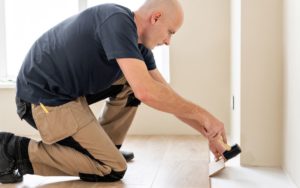

Step 3: Cost of Repairing Water Damaged Flooring
If you are a professional, congratulations because you will only need to consider the cost of supplies for treating damaged floorboards. However, water damaged wood flooring is much more difficult to restore compared to ordinary installations or floorboard replacements. As such, we HIGHLY recommend leaving it to the professionals.
Note: The following information is collated from trusted and up to date sources including Australasian Timber Flooring Association (ATFA) and our own in house research team.
Cost of Damaged Floor Removals:
The cost of letting the experts remove (and dispose) water damaged flooring depends on the difficulty of the job. Floating floors and carpet tend to be significantly cheaper than timber boards which have been glued and nailed into the subfloor.
| Flooring Type | How it was Installed | Removal & Disposal Cost |
| Carpet | Edge Grip | $5 – $10 per square metre |
| Laminate Flooring | Floating | $10 – $15 per square metre |
| Bamboo Flooring | Floating | $10 – $20 per square metre |
| Hybrid Flooring | Floating | $10 – $20 per square metre |
| Luxury Vinyl Planks | Floating | $10 – $20 per square metre |
| Luxury Vinyl Planks | Glue Down | $20 – $30 per square metre |
| Vinyl Sheets | Glue Down | $20 – $30 per square metre |
| Engineered Timber | Floating | $15 – $25 per square metre |
| Engineered Timber | Glue Down | $40 – $50 per square metre |
| Solid Timber | Nail & Glue Down | $40 – $50 per square metre |
Cost of Subfloor Drying (Materials/Tools):
Most appliances which can assist in drying the subfloor if it is wet or flooded you probably already own. Note that these are entirely optional and are purely for speeding up the drying process. Here are the general prices of important materials and tools in NSW which can quickly dry the subfloor:
| Tool/Material | Typical Cost |
| Dehumidifier | $150 – $800 per dehumidifier |
| Fans | $20 – $100 per fan |
| Water Absorbing Minerals | $1.20 – $3 per litre |
| Water Absorbing Sandbags | $20 – $40 per bag |
Cost of Flooring Restoration:
Flooring restoration is usually the most costly part of the process. The table below breaks down the typical cost of purchasing and getting the floors installed in NSW.
| Flooring Type | Supply Cost (SQM) | Installation Cost (SQM) | Installation Difficulty |
| Laminate Flooring | $20 – $50 | $20 – $30 | 1.5/5 |
| Hybrid Flooring | $40 – $60 | $25 – $35 | 2.0/5 |
| Luxury Vinyl Planks | $30 – $60 | $30 – $40 | 2.0/5 |
| Vinyl Sheets | $50 – $60 | $35 – $45 | 4.0/5 |
| Bamboo Flooring | $60 – $75 | $20 – $30 | 1.5/5 |
| Engineered Timber | $60 – $120 | $30 – $40 | 2.5/5 |
| Solid Timber | $80 – $130 | $40 – $50 | 4.5/5 |
Keep in mind that you can always contact us for a consultation. We can give you a definitive price after conducting a free on-site inspection. FloorVenue can always be reached through our live chat or contact us form.
These are only general prices, contact us if you wish to have an exact quote. FloorVenue aims to always have the most price efficient products and services across the ranges without skimping on quality.
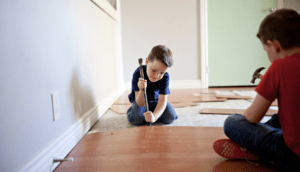

Step 4: Preventing Water Damaged Wood Floors
Now that we know how to resolve water damaged flooring, it is important to address how we can avoid the problem from arising again in the future. After all, a wise person once said:
“The best time to solve a problem is before it begins.”
There are many ways to protect your flooring from water, however there are unanimously obvious solutions to avoid all these issues – Waterproof Flooring!
On top of that, you should also consider increasing ventilation in the underfloors, which is a job for the builders.
Waterproof Flooring Options:
- Porcelain & Ceramic Tiles – The best flooring for any wet area – tiles – will come in handy against any form of water or moisture. Porcelain tiles are slightly stronger and less porous than ceramic tiles, but are slightly costlier. Both will do the job!
- Hybrid Flooring – Hybrid floors combine the best of laminate flooring’s durability and vinyl flooring’s waterproofing. These come in two forms: Stone-Plastic Composites (SPC) and Wood-Plastic Composites (WPC), both of which are 100% waterproof and look like real timber. Feel free to explore hybrid flooring here!
- Vinyl Plank Flooring – Vinyl floors are made of polyvinyl chloride (PVC) which is a form of plastic. Vinyl floors are usually designed for both residential and commercial areas, and are fully waterproof. Check out our full range of vinyl flooring!
- HydroPro Timber – HydroPro Timber is the only real timber engineered flooring which uses a 100% waterproof core board as opposed to traditional plywood bases. The pinnacle of modern flooring technology allows you to enjoy the beauty of real Australian hardwood flooring without worrying about water and moisture! Interested in learning more about HydroPro Timber?
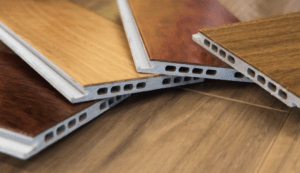

Protecting Wood Flooring Tips:
- Entrance Mats – The lowest hanging fruit for preventing water damage on flooring is definitely placing door mats at all entrances and even one outside the bathroom. Simple drying your shoes and taking them off can make a big difference.
- Water Resistant Underlay – The next best solution aside from waterproof flooring is to install a moisture barrier underlayment between your subfloor and floorboards. Moisture barriers are especially useful in climates with higher humidity. This is an inexpensive and very simple solution which most can install even as a part of a DIY repair.
- Wipe Up Spills – Wiping it up should be automatic when you see a spill or small puddle on your wood floors. Letting your floorboards soak up the water is a surefire way to see bubbling appear.
Conclusion – Water Damaged Flooring
Too long, didn’t read? We’ve made a quicker version for you to sum it all up!
Preventive Measures:
The best thing you can do for your floors is to make them waterproof by installing tiles, hybrid flooring, vinyl planks or HydroPro Timber. Furthermore, use entrance mats, water resistant underlayment and show diligence in wiping up spills immediately for wood flooring.
Fixing Water Damaged Floors:
The first step is to identify the type of water damage. Unknown causes of warping is an indicator of leaks or subfloor moisture/flooding. You should immediately request a flooring specialist to conduct an on-site inspection to determine the cause. FloorVenue offers free on-site inspections at your request.
If it is from an obvious cause like excess water when mopping or pet accidents, these can often be fixed by either a DIY floorboard repair by replacing the damaged planks, or by hiring a professional to get the job done.
Cost of Fixing Flooring:
The total cost of repairing your floor can be broken into four parts:
- Subfloor Drying (May not be necessary / Optional) – In cases where the subfloor moisture is too high for an immediate floor replacement, it will be necessary for drying to take place first. The cost of drying your subfloor depends entirely on how fast you want it to dry.
- Damaged Floor Removal – Typically ranges between $15 – $40 depending on the material and how it was installed. Floating floors are much cheaper to remove than solid timber boards which have been directly installed with nails and glue into the subfloor.
- Purchasing New Floors – The cost of new floors depends entirely on the type of floors. Synthetic floor options like laminate, hybrid and vinyl options are much cheaper than bamboo, engineered and solid timber flooring which are made of natural materials. You can find our cost guide by scrolling upwards.
- Installing New Floors – Installation costs are based on the difficulty of installing. Floating floors are much more affordable at $25 – $30 per square metre, whereas direct-stick installations for solid timber can go up to $50 per square metre. Again, our cost guide can be found if you scroll up.
Too confusing? You can always contact one of our friendly Flooring Consultants for a quick analysis of your situation and book a free on-site inspection.






























